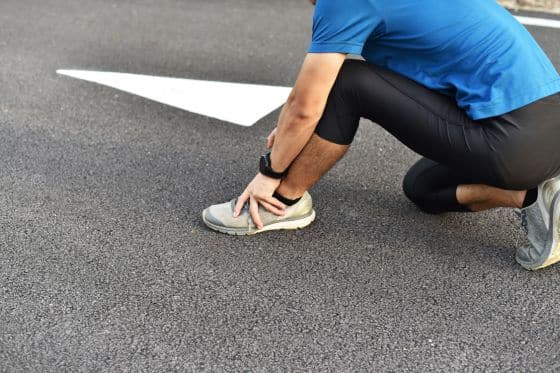For runners and active individuals alike, the feet and ankles carry more than just the body—they carry a lifestyle. When something starts to feel off in these areas, it doesn’t just affect movement. It can disrupt training, daily routines, and the confidence to stay active.
Understanding the common causes of foot and ankle pain is the first step in making smart, informed decisions about how to stay mobile and supported. Whether the goal is to keep up with a running routine, return to weekend hikes, or simply feel more stable during everyday movement, knowing what might be contributing to discomfort is key.
At Ageless Agility, we work with individuals who want to stay active without relying solely on rest, temporary fixes, or invasive solutions. In this guide, we’ll explore the most common causes of foot and ankle pain and how to take a proactive approach to managing them naturally.
1. Overuse and Repetitive Stress
One of the most frequent sources of foot and ankle discomfort comes from doing too much, too soon. Repetitive activities like running, jumping, or long-distance walking place constant stress on the joints, muscles, and connective tissues of the lower leg. Without enough recovery, the tissue may begin to respond with soreness, tightness, or even inflammation.
Small increases in mileage or training intensity are a good thing. But when the workload ramps up too fast, or recovery habits fall behind, the body may struggle to adapt. Over time, this can lead to common overuse conditions like tendinopathy or stress on the plantar fascia.
Support Strategy:
- Gradual progression in training plans
- Cross-training to reduce repetitive load
- Incorporating foot and ankle mobility work into weekly routines
2. Lack of Strength and Stability
Many people focus on how the foot hits the ground, but not enough attention is given to what’s happening further up the chain. Weakness in the hips, core, or calf muscles can cause the ankle joint to compensate. This compensation can lead to uneven forces being distributed through the foot and ankle.
When stability is lacking, balance can be affected, and the joint can become less efficient at absorbing impact during movement.
Support Strategy:
- Strengthening the glutes, calves, and core
- Single-leg balance and control drills
- Dynamic warm-ups before training
3. Improper Footwear
Footwear has a direct impact on how forces are transferred through the feet and ankles. Shoes that are too worn, too stiff, or poorly matched to a person’s foot structure can lead to changes in mechanics. This often shows up as arch strain, heel discomfort, or pressure on the forefoot.
Running shoes, for example, should be replaced every 300 to 500 miles depending on use and gait. Everyday footwear also matters—unsupportive sandals or narrow dress shoes can contribute to long-term issues if worn regularly.
Support Strategy:
- Choosing shoes based on foot type and activity
- Replacing running shoes consistently
- Avoiding prolonged use of unsupportive footwear
4. Limited Mobility in the Ankle Joint
Ankle mobility affects everything from stride length to balance. When there’s restriction in dorsiflexion (the ability to bring the toes up toward the shin), it can create a ripple effect during walking or running.
Compensations for limited mobility might show up as altered gait, increased stress on the knees, or heel discomfort. This is especially important for runners, where each stride magnifies even small movement limitations.
Support Strategy:
- Regular ankle mobility drills and calf stretches
- Soft tissue work around the lower leg and foot
- Movement assessments to uncover mobility gaps
5. Old Injuries That Never Fully Recovered
Past injuries—even minor ones—can influence current movement patterns. A previously sprained ankle, for instance, might result in stiffness, instability, or hesitation when loading the foot. If those patterns persist without support, the joint can remain vulnerable.
Many active adults return to activity without a full recovery plan. That’s when subtle compensations begin to build up over time, often leading to new discomfort down the road.
Support Strategy:
- Revisiting old injuries with a movement specialist
- Strength and balance retraining post-injury
- Awareness of current compensations or habits
6. Plantar Pressure and Foot Mechanics
Every step involves a shift in weight from heel to toe. For some individuals, how that weight is distributed can lead to increased stress on one part of the foot. Flat feet, high arches, or uneven foot strikes all play a role.
These patterns aren’t inherently bad—but when combined with training volume, footwear issues, or muscle imbalances, they can lead to discomfort or changes in performance.
Support Strategy:
- Gait analysis to understand foot strike mechanics
- Custom mobility and strength programs
- Activity modifications based on structure and movement
7. Standing or Walking for Long Periods Without Support
Even those who aren’t running regularly may notice foot and ankle issues from long days on hard surfaces. Prolonged standing, walking in flat shoes, or spending hours on uneven ground can add stress to the lower leg.
Without supportive routines or footwear, even low-impact activity can accumulate into discomfort over time.
Support Strategy:
- Use of cushioned or supportive shoes during long days
- Stretching breaks during the day
- Movement assessments to catch early signs of overload
Final Thoughts: Proactive Steps Matter
The body is designed to move—but it moves best when supported. Understanding the common causes of foot and ankle pain can help active adults take smarter steps toward movement that feels better, lasts longer, and fits their lifestyle.
At Ageless Agility, we offer one-on-one telephone consultations to help runners and active individuals build custom plans around mobility, strength, and performance. These relaxed conversations are a chance to reflect on movement history, current goals, and what might help support progress.
Call (954) 519-5404 or click here to book a Free Telephone Consultation Today to learn more about the right next step. We’re here to help every stride feel strong and supported.
More free resources:
Download our free running report – Free Running Injury Report – Running Injury Expert, Davie, Florida, Ashley Kranz
Book a free discovery visit – Request A FREE Discovery Visit – Running Injury Expert, Davie, Florida, Ashley Kranz
Read our blog – Running Injuries: What Every Runner Should Know to Stay Strong, Resilient, and on the Move – Running Injury Expert, Davie, Florida, Ashley Kranz

